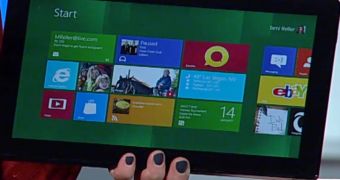Windows 8 was meant to be used on mobile devices too, which means that support for sensors will also be included in it.
In fact, it appears that Microsoft has been keen on packing the functionality inside its upcoming platform, and that this was a focus from day one. Now, the company has provided some more info on what the support for these sensors involves.
“The first thing we explored about sensors was how Windows 8 should use them at the system level, to adapt the PC to the environment while preserving battery life,” Gavin Gear, PM on the Device Connectivity team, explains in a recent blog post.
Windows 8 will arrive with automatic display brightness control, a feature that was first introduced in Windows 7 via ambient light sensors (ALS).
This is one of the most important features packed in modern platforms, since newer displays can deliver up to twice the brightness that was available a few years ago.
“By dynamically controlling screen brightness based on changing ambient light conditions, we can optimize the level of reading comfort, and save battery life when the screen is dimmed in darker environments,” Gear explains.
Another feature that tablet PCs feature today, and which will be included in Windows 8 as well, is automatic screen rotation. Smartphones and other mobile devices sport it as well.
“When you rotate the device, the graphic display will also rotate and adapt to the new orientation (including adapting to aspect ratio changes),” Gavin Gear notes.
“Data from an accelerometer allows the device to determine its basic orientation. By automatically rotating the screen, people can use their devices (primarily slates and convertibles) in a more natural and intuitive way, without needing to manually rotate the screen with software controls or hardware buttons.”
While these are the benefits that users will receive from the sensors included in Windows 8, there are also some capabilities that developers will be able to take advantage of when building apps for the platform.
Applications designed for the upcoming operating system will understand motion and screen rotation, Microsoft notes.
Some of the sensors that could fill the needs of specific games and applications would include accelerometer, compass, 3D magnetometer, and gyro.
Since each of these has its flaws, Microsoft decided to test them together, and discovered that they could easily complement one another. Thus, they combined their features inside a single process called sensor fusion.
“Essentially, sensor fusion is a case where the whole is greater than the sum of the parts. A typical sensor fusion system uses a 3D accelerometer, a 3D magnetometer, and a 3D gyro to create a combined ‘9-axis sensor fusion’ system,” Gavin Gear explains.
“By integrating a sensor fusion solution, Windows 8 provides a complete solution for the full range of applications. Sensor fusion in Windows solves the problems of jittery movement and jerky transitions, reduces data integrity issues, and provides data that allows a seamless representation of full device motion in 3D space (without any awkward transitions).”
The sensor fusion system was demoed in September at BUILD, and is now available for purchase from ST Microelectronics. Called “ST Microelectronics eMotion Development Board for Windows 8” (model # STEVAL-MKI119V1), it can be attached to a PC via USB, and developers can already start designing Windows 8 apps that take advantage of it.

 14 DAY TRIAL //
14 DAY TRIAL //